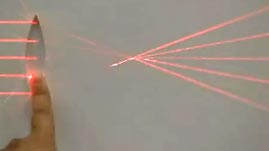Teachers' Domain - Digital Media for the Classroom and Professional Development
User: Preview

Source: Rutgers Physics and Astronomy Education Research Group
In this interactive activity featuring videos adapted from the Rutgers PAER Group, observe the refraction of light as it passes through transparent objects. In the first example, when a convex lens is placed in the path of parallel beams of light, the beams converge after passing though the lens. In the second example, when a concave lens is placed in the path of parallel beams of light, the beams diverge after passing through the lens. In the third example, when a rectangular piece of glass is placed in the path of a beam of light, the light bends at the boundary both into and out of the glass.
One of the most well-known properties of light is c, the speed of light in a vacuum (approximately 300,000 km/s). However, the speed of light is slower when traveling through a transparent material. For example, the speed of light traveling through glass is about two-thirds its speed in a vacuum. Depending on the material, the speed of light will vary. This occurs because the light is absorbed and reemitted by the electrons in the material, causing a delay. This slowing can be described by the "index of refraction," defined as the ratio of the speed of light in a vacuum divided by the speed of light through the material; the higher its index of refraction, the slower the speed of light will be when traveling through that material.
When light crosses the boundary between two transparent materials that have different indices of refraction (such as air and glass), it may also undergo a change in direction. If the light approaches the boundary at an angle not along the normal line (perpendicular to the boundary), the change in speed causes it to bend. This bending due to the change in speed is called refraction. If the light enters into a material with a higher index of refraction, it bends towards the normal line as it slows down in the new material. If it enters into a material with a lower index of refraction, it bends away from the normal line as it speeds up in the new material.
The refraction of light as it passes from one material to another is the foundation for many optical devices, including magnifying glasses, eyeglasses, microscopes, and cameras. These devices control the path of light through the use of lenses—transparent objects, usually made from glass or plastic, that are specially shaped and designed to refract light in specific ways. There are two basic types of lenses: converging and diverging. When parallel rays of light pass through a converging lens, they meet at a common point. Conversely, when parallel rays of light pass through a diverging lens, they spread apart.
In a typical human eye, light from an object enters the eye and passes through a lens that focuses the light on the retina. However, for some people, light does not focus on the retina and they have trouble seeing images clearly. A nearsighted eye focuses the image in front of the retina; eyeglasses made with diverging lenses correct for nearsightedness by diverging the light just enough so that the image comes into focus on the retina instead of in front of it. Alternatively, a farsighted eye has the image coming into focus behind the retina; eyeglasses made with converging lenses correct for farsightedness by converging the light and moving the focused image forward and onto the retina.
 Loading Standards
Loading Standards Teachers' Domain is proud to be a Pathways portal to the National Science Digital Library.
Teachers' Domain is proud to be a Pathways portal to the National Science Digital Library.
